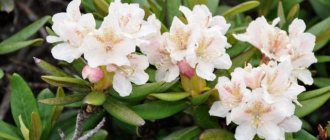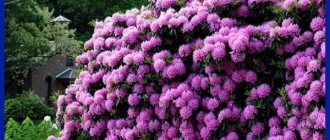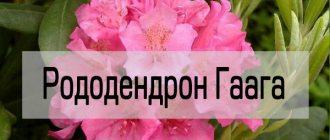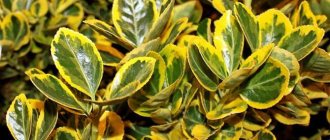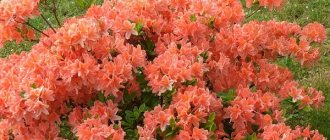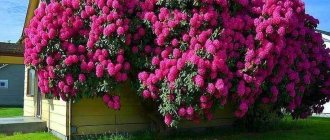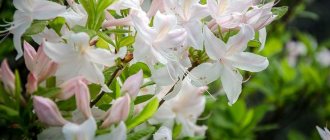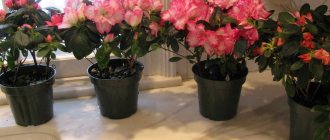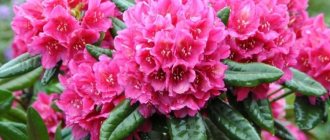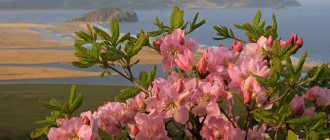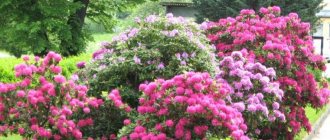Description of Japanese rhododendron
In the process of long-term selection, about 12 thousand varieties of Japanese rhododendron were bred. Most of the plants reach a height of 2 m. Flowering duration is 2 months (May and June), with up to 400 flowers blooming on 1 bush. Bushes that have no foliage or are just beginning to appear look very beautiful, but the branches are strewn with flowers. Japanese rhododendron inflorescences are formed from 10 or more corollas, most often having an orange-yellow hue. After the corollas wither, fruits are formed - boxes with very small (smaller than poppy seed) seeds that ripen by October.
The life expectancy of the plant is high, the tallest varieties grow up to 100 years. There are varieties with erect and creeping stems. Mature shoots have a pronounced brown tint, and the most tender young and bare shoots have a green tint. The root system is fibrous, without hairs.
In the catalogs of planting material manufacturers you can find many varieties and photos of Japanese rhododendron. The most common shades are orange, yellow, pink and white.
To your laptop.
Mycorrhiza. Please don't be afraid of this obscure word. Mycorrhiza (mykes - mushroom + rhyza - root), that is, the symbiosis of fungi with plant roots, is present wherever grasses, trees and shrubs grow.
Mycorrhizal fungi are not only the usual cap mushrooms, but mainly microscopic ones invisible to the eye, living on woody debris on the surface of the earth and in the soil. The fungus decomposes plant debris and helps rhododendrons extract nutrition from indigestible, acidic organic materials.
To start the “mushroom process”, you need to create an environment favorable for symbiotic fungi and introduce a mushroom “starter”, which is found, for example, in heather soil.
High peat. Peat of raised bogs, formed on the basis of sphagnum mosses. It has high moisture capacity and acidic reaction pH=3.5-4.0. A necessary component of the soil substrate for most rhododendrons. Usually has a reddish color and a fibrous structure.
Heather (coniferous) land. The litter is made of old coniferous forest, pine or spruce, in the lower tier of which there are lingonberries, heather, wild rosemary, blueberries, blueberries. Includes all organic components and part of the parent soil, usually to a depth of about 10-15cm. Contains everything most rhododendrons need, including the mycorrhiza they need.
Turf soil (turf) is the upper layer of soil, densely intertwined with roots, of an old, preferably undigged, meadow, the herbage of which is dominated by cereals.
Leaf soil is the top, 5-15 centimeter, layer of soil richly fertilized with organic residues from an old broad-leaved or mixed forest, which contains species such as linden, oak, maple, aspen, spruce. In addition to the organic component, it also contains beneficial fungal microflora.
Coniferous litter. The topmost (usually no more than 5 cm) layer of litter from under densely growing conifers. Includes needles of varying degrees of decomposition, small twigs, cones...
It is best to collect litter from homogeneous stands. In addition to pine and spruce, you can use litter from larch, fir, and false sugi.
Heather compost - Those who want to master the cultivation of heathers need to learn how to prepare heather compost. It is prepared on the basis of heather soil; pine litter; wood dust; high peat; pine and spruce branches, cones, bark; leaves of forest trees (birch, aspen, linden...), herbs that grow under the forest canopy.
The compost heap should be placed in a shady part of the garden, and arranged in the form of a wide (100-150cm) bed up to 60-70cm high, the top of which is given a trough-shaped shape. The components are laid in small (about 5 cm) layers. Compost is considered mature when the bark is completely decomposed. It contains everything you need to grow ericaceae, including mycorrhizae. It can be used both as a substrate for planting and for fertilizer.
Varieties of Japanese rhododendron
The classic orange Japanese rhododendron will brighten up any area, but the plant looks even more beautiful when surrounded by other shades. The following varieties are most popular among gardeners in central Russia.
Japanese salmon rhododendron
The hallmark of this variety is not only the bright shade of lush and large inflorescences. The winter hardiness of Japanese salmon rhododendron is its valuable quality, which made it possible to grow it not only in the middle zone, but also in the front gardens of the Moscow region. It is easy to recognize the variety by key features:
- height – up to 2 m;
- flowers are salmon-colored, up to 7 cm in diameter, collected in inflorescences of 6-12 pieces;
- flowering duration - 3 weeks from mid or late May;
- elongated green foliage 10-12 cm long acquires a fiery hue by September;
- gray bark.
For planting, seedlings aged 2-4 years are purchased. The unpretentious Japanese salmon rhododendron is planted where there is not sun all day, otherwise the delicate flowers will easily burn. Places near fences are good. The variety is very moisture-loving, but requires fertilizing once every 2-3 years.
Rhododendron japonica cream
The creamy shade of the petals in this group of varieties is often combined with a bright yellow flower core and equally large stamens. A pleasant delicate aroma is characteristic of all Japanese rhododendrons. Its peculiarity is that it does not tolerate proximity to large trees, but it thrives on lawns surrounded by grass and on slopes. It is advantageous to plant in areas with large differences in elevation, so it is often used to create terraced landscape compositions.
Depending on the variety, the height of the bush reaches 1.2-2 m, and grows in one place with proper care for up to 40 years. The leaves grow up to 4-10 cm in length, and the flowers are collected in inflorescences of 6-12 pieces. The corollas are so lush that the foliage behind them is almost invisible. By autumn, the foliage on the bushes turns yellow-purple instead of dark green.
Rhododendron japonica Babushka
Belongs to the dwarf varieties. The compact bush grows only 50 cm in height and width. The semi-double carmine-pink flowers are very lush. Only the red Japanese rhododendron looks brighter. The shiny dark green foliage turns yellow in autumn. The variety is semi-evergreen.
It is recommended to plant in semi-dark areas. Belongs to winter hardiness zone 6. Loves abundant watering and mulching. Bushes require pruning once a year - late autumn or early spring before buds open.
Rhododendron japonica Schneeperle
Azalea rhododendron japonica Schneeperle is one of the earliest varieties. Flowering begins in mid-April and lasts until the end of spring. Pale white flowers look great in holiday bouquets, such as wedding bouquets. The corollas of the flowers are relatively small - 4-5 cm in diameter, but very lush, reminiscent of tiny roses.
The bush is unpretentious, but grows very slowly. A 10-year-old plant has a height of only 35 cm and a width of 55 cm. The main application is the formation of borders in multi-row decorative plantings. The peculiarity of the variety is that it requires formative pruning after flowering in June. This gives the plant an incentive to form flower buds for the next season. Withstands frosts down to – 29 °C. The root system is shallow, prone to growing in breadth. It is highly not recommended to bury the root collar, as this can lead to the death of the bush.
Rhododendron japonica Snow White Prince
This variety can also be found on sale under the name White Prince. The flowers are either completely snow-white or with a soft pink center. It looks especially impressive next to the orange Japanese rhododendron/azalea. The bush is tall - up to 2 m in height. The flowers are medium-sized - 6-8 cm in diameter. The leaves are elongated, green in color, up to 10 cm long. Winter hardiness is average; in regions with frosty winters, covered agricultural technology is recommended. Planting material – 3-year-old seedlings. Younger seedlings obtained from seeds are grown in greenhouse conditions. For planting in open ground, choose a shaded place, well protected from strong winds and direct sunlight.
Important! Ideal neighbors are deciduous shrubs and conifers.
Preparing for winter
Japanese salmon rhododendron is frost-resistant and can survive the winter without shelter. But no one can predict whether winter will be snowy. Therefore, it is better to play it safe and prepare the plant for wintering. Young bushes up to two years old also need obligatory shelter.
Young rhododendron should be covered for the winter
In addition to shelter, rhododendron also needs to receive moisture in winter. To do this, in the period before frost (from early autumn), you need to water the plant every other day, with about 12 liters of water. After this, a thick layer of pine bark mulch is laid. When frost occurs, the lower branches are sprinkled with compost. You can use pine needles or peat.
To protect the tree from snow and sun, you need to carefully tie the branches together without damaging the buds. Drive pegs around the bush and attach covering material to them. It could be burlap, agrotex, or even a homemade “house” made of polypropylene.
When the frosts stabilize and the temperature on the thermometer scale does not fall below -10 degrees, the shelter must be removed to prevent overheating. The cover must be removed gradually so that the sun does not burn it. It is enough to allow air access.
If you do everything consistently and with love, your diligence will be rewarded with the lush flowering of Japanese rhododendron. Replenish your garden with this unique shrub; with proper care, it will delight you year after year.
Winter hardiness of Japanese rhododendron
Not all varieties are equally good for regions with frosty winters. Whether a particular variety is suitable for a given area must be clarified in advance. Here is a list of the most winter-hardy varieties that can be grown even without covering the bushes for the winter:
| Name | Winter temperature limit, °C |
| Grandmother | — 23 |
| Golden Lights | — 42 |
| English Roseum | — 34,4 |
| Karens | — 31 |
| Mount Saint Helens | — 32 |
| Nova Zembla | — 32 |
| PJM Elite | — 32 |
| Rosy Lights | — 42 |
| Roseum Elegans | — 32 |
| White Lights | — 42 |
In its natural habitat, Japanese rhododendron grows on mountain slopes at an altitude of up to 2000 m above sea level.
Important! The main condition for a favorable winter is reliable protection from the wind that blows away the snow.
Planting and caring for Japanese rhododendron
It is quite possible, if desired, to grow a beautiful Japanese rhododendron from seeds. This is an interesting matter and will take more than one year. The fact is that young plants in the first year of life are extremely demanding of care, so sowing is carried out in containers where bushes are usually kept for up to 3 years. Only after this are they transferred to flower beds or put up for sale. The older the bush, the higher it is valued. If the average price of a 3-year-old Japanese rhododendron ranges from 300 to 1000 rubles, then for a 7-year-old one the fair value is from 15 thousand rubles.
Long and slow growing season is the main reason why varietal Japanese rhododendrons are sold in specialized stores in the form of seedlings of different ages. It is enough to carefully deliver it to the site and plant it in the chosen place in order to admire its lush spring flowering for many years to come. The growth in one year is small; low-growing varieties can increase in height by only a few centimeters per season.
Selection and preparation of a landing site
The vast majority of Japanese rhododendrons do not tolerate direct sunlight. It is recommended to plant bushes where the sun appears only for some part of the day - morning or evening. It is optimal to plant bushes along fences or borders, as well as under the cover of a facade or other bushes. In a completely open clearing, where the bush cannot hide in the shadows for even a second, its flowers and leaves will be seriously tested. The risk of death due to burns is very high.
The soil in the places where the plant comes from is least similar to black soil. In fact, it is a complex substrate in which all kinds of plant debris abound: branches, pine needles, foliage. To plant bushes, prepare fertile soil by mixing it generously with mulch and adding clean river sand for additional looseness. In clay and heavy soil, Japanese rhododendron will wither. Excellent additives are peat and rotted pine needles. The acidity of the substrate should be high; Japanese rhododendrons do not like neutral or alkaline soils.
Seedling preparation
Since planting material comes from nurseries where the bushes were kept in greenhouse conditions, they need to be acclimatized before planting in open ground. To do this, the tub with the plant is hardened. First, for half an hour, and then gradually increasing the time interval, it is taken out into the fresh air at the warmest time of the day, leaving it in partial shade. After 7-10 days, you can begin planting in a pre-prepared hole.
Rules for planting Japanese rhododendron
The root system of the bush does not exceed 1 m in height for an adult plant. The planting hole is dug to a depth of 50 cm. Vermiculite or cheaper expanded clay and fine crushed stone must be poured onto its bottom for optimal drainage.
The removed soil is thoroughly mixed with pine needles, peat, mulch, and a little complex mineral fertilizer is added. For planting, choose a cloudy but warm day. After placing the roots in the hole, they are covered with the prepared substrate and watered abundantly. A funnel is formed around the trunk of the bush so that when watering the water does not spread past. The top of the soil must be sprinkled with mulch. The root collar cannot be buried; it must be level with the ground level.
Watering and fertilizing
Japanese rhododendron does not tolerate drought well. If there is a natural or artificial pond on the site, then bushes can be planted along its banks. In other cases, throughout the warm season, Japanese rhododendron needs regular, abundant watering. Mulching the planting with pine needles or dry leaves will help prevent critical drying out of the soil under the bushes.
Japanese rhododendron requires almost no feeding. Once a season, a sodium-potassium-phosphorus combined mixture is added at the rate of 5-10 g/m2. The rest of the plant comes from rotting plant residues. Several times during the summer, pine needles, peat, and heather soil are added under the trunk.
Important! Loosening is never carried out.
Trimming
The picture shows what a Japanese rhododendron looks like after pruning (2). They do it several times. There are different types of pruning:
- sanitary – in early spring, remove broken and frozen branches from the bushes;
- formative - before flowering, get rid of bare shoots without branches to get a symmetrical, neat crown;
- rejuvenating - after flowering, performed to stimulate growth if necessary, involves shortening the shoots by 20 cm.
Preparing for winter
Rhododendrons in Japan, growing on gentle mountain slopes, tolerate snowy winters well and do not require any care. In Russia, it is better to take care of the bushes in advance, increasing the chances of the Japanese rhododendron to survive the winter safely.
First of all, pruning is carried out, removing branches affected by diseases and pests. If the bush is old enough, then you can shorten the shoots by 20-30 cm to stimulate the active growth of dormant buds. Winter-hardy varieties do not need shelter, but semi-evergreen varieties will require shelter. Agrofibre is used for this. The covering material has good breathability, but does not allow the branches of the bushes to freeze out in dry winters with little snow.
Another important activity after the Japanese rhododendron leaves fall is watering and fertilizing. Up to 10 liters of water are poured under each bush, dissolving 8 g of superphosphate and 6 g of potassium sulfate in it.
Prevention of various problems
If the Japanese azalea withers, does not bloom, the leaves are sluggish and lifeless - the flower is sick.
- It is necessary to check for the presence of harmful insects and eliminate the problem by treating with chemical solutions.
- It is imperative to comply with the conditions for keeping the Japanese azalea. From sudden freezing or drafts, it can develop necrosis - the leaves turn brown. It is urgent to adjust the temperature and move the azalea to a brighter place or protect it from drafts and gusts of wind.
- Discolored spots have appeared on the leaves - you need to acidify the soil when watering.
- When the leaves began to crumble and turn yellow, the Japanese beauty was overheated and lacked moisture. Watering should be increased, a daily shower or spraying should be added.
- With the same symptoms, the cause may be improper soil. Here you need to transplant into the “correct” substrate.
All life on Earth requires care and love. In order for the Japanese azalea to grow and give extraordinary flowering flower beds, you need to put in a lot of effort and work. Then a flowering paradise will appear in the garden - the miracle of the fabulous Japanese azalea.
Reproduction
Japanese rhododendron lends itself well to propagation by cuttings, layering, and dividing old bushes. Rare hybrids are grafted onto the trunks of winter-hardy varieties. If you want to get an exact copy of your favorite Japanese rhododendron, you should cut a cutting of 15 cm in length in the spring. The bottom 2-3 leaves are removed. A branch of Japanese rhododendron is placed in moist soil and expected to take root for 2-3 months. If by August the root system of the bush has formed of sufficient size, then it can be planted in open ground, otherwise it is postponed until next year. In winter, containers with cuttings are left in a lighted room at a temperature of + 8-12 ° C.
Diseases and pests
With insufficient aeration of the root system, Japanese rhododendrons suffer from numerous fungal diseases. For prevention, it is recommended to regularly treat the bushes with a solution of Bordeaux mixture.
If the soil is not acidic enough, Japanese rhododendrons may suffer from root rot. This can only be corrected by increasing the acidity of the soil, for example, sprinkling the soil with pine litter and peat. Solutions of colloidal sulfur, ammonium nitrate, and potassium sulfate also help.
Numerous garden pests, common in central Russia, affect cultivated and wild varieties of Japanese rhododendron. Insecticides showed good effectiveness: “Iskra”, “Aktellik”, “Fitoverm”, “Aktara”.
Growing conditions
The natural habitat of deciduous rhododendrons is southern slopes in the form of sunny areas among shrubs and grasses. The culture is often found on mountainous terrain. The flower is light-loving, but does not tolerate midday sun rays. Rosewood bushes are planted near fences or buildings, under the crown of deciduous and coniferous garden inhabitants, among ornamental vegetation, to ensure a balance of light and shadow during the day.
What does Japanese rhododendron look like?
The culture prefers relatively acidic soils with pH values of 6-7.5. Well-warmed soils with a southern slope are suitable for growing. Deciduous rhododendrons are moisture-loving, but the roots are afraid of flooding, so having well-drained soil is important. In the middle zone, it is advisable to shelter rosewood bushes from winter winds, although the crop is frost-resistant and can withstand temperatures of -26-29°C without damage.

